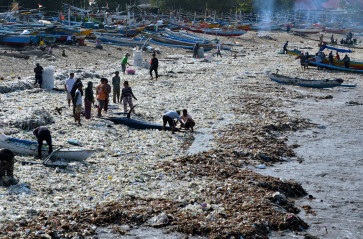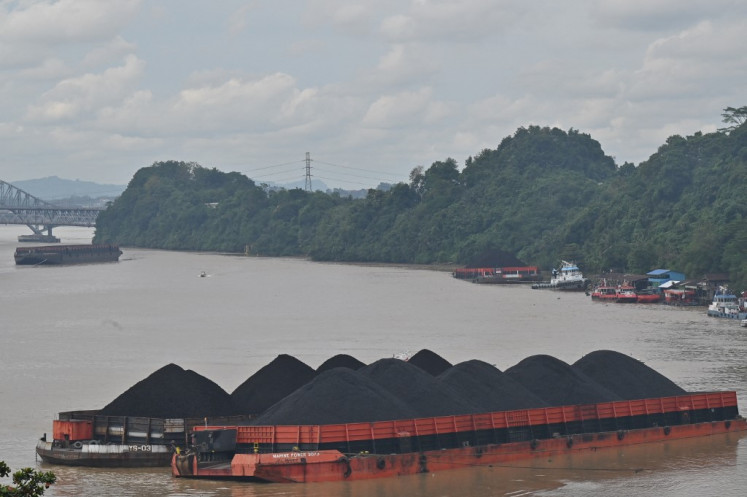Human tragedy under rising lake waters
Inventive: Residents create underwater gardens because of the frequent flooding
Change text size
Gift Premium Articles
to Anyone

I
span class="caption" style="width: 398px;">Inventive: Residents create underwater gardens because of the frequent flooding.Rooftops break the water’s surface of Lake Buyan in central Bali’s mountainous region.
The ancient lake formed millennia ago has been a breadbasket for the island with its ample water supply and rich soil, however, today rising water levels are drowning houses, schools, roads and farms.
According to Udayana University’s head environmentalist, Dr. Wayan Arthana, Bali’s lake systems are under serious threat from silting, the silt causing water levels to rise in the catchments circled by great mountains that do not allow for runoff.
“The problem is all our lakes, such as Batur, Buyan and Tamblingan have no inlet or outlet, so they are almost static in terms of limnology, when something enters these lakes it never leaves, they are never flushed,” says Arthana of the lakes that are at risk of dying through silting.
And if these lakes die, Bali, he says, could become a desert.
“Bali is dependent on the lake systems to water the island’s lower areas through underground springs soaking out from the lakes. The lakes feed the rivers. With these lakes Bali is green, without them it would be a desert,” Arthana warns of a potential environmental time bomb if sediment in the lakes continues to grow.
One of the greatest problems in Lake Buyan is the constant growth of water hyacinth. The plant, with its succulent leaves and distinctive mauve flowers, in small volumes can act as a trap for pollutants from both the air and water, explains Arthana, however, when left to grow wild, die off and decay the plant adds dramatically to the volume of silt in the lakes, particularly in Lake Buyan.
“The problem with the water hyacinth is that local people use it for animal feed and as fish traps. The fish are attracted to the water hyacinth roots, making it easier to fish. So, now we are in a dilemma. A lot of research on water hyacinth shows it traps air and water pollution, but then it needs to be taken out of the [lake] system. If we are doing that it is good, as the water hyacinth cleans the water, but in wild areas the water hyacinth is left to die and takes that pollution to the bottom of the lake,” says Arthana of a double-edged sword hanging over Lake Buyan that is rising, say locals, centimeters a day.
While Lake Buyan’s water levels are believed to be caused by greater silt collecting on the lake bottom due to farming practices and the water hyacinth, the steady rise in the remote Lake Tamblingan is less easy to explain, says Arthana.
“Tamblingan is the most isolated area, it’s very difficult to get there, but because it is the smallest lake with a large volume of rain, it floods rapidly. There is not a large farming population there, except for a small settlement to the south of the lake. If we look at the pattern of Lake Tamblingan we see it is very isolated with protected forests surrounding the lake, so there is less sedimentation, less erosion washing soils into the lake. So it is a small lake with less [human] utilization and the same intake of rainwater,” says Arthana, suggesting that Tamblingan’s floods are part of a natural cycle.
The clash between the lake systems and human needs comes in what Arthana calls the “oscillation zone”, the intertidal area where the lakes’ waters rise and recede in changing seasons.
“The problem [of flooding] is that human settlement placed their homes too close to the lakes. If they built further from the shores there would be no impact,” says Arthana. He adds the government is planning to dredge the lakes to reduce silt build-up on the lake bottoms.
Science as to the lakes’ rising waters is clear, heavier silt volumes from farming, high rainfall and organic detritus from decaying water hyacinth. The scientific solutions appear simple, planting trees to trap soils on land, removing water hyacinth before it dies off and moving farming away from the shores of the lakes. however, the human face of the ongoing disaster is far more complex.
Forty-seven-year-old widow Anik has lived on the shores of Lake Buyan for the past two decades. She came to the area from Madura after she got married. Her husband died seven years ago and this year her bamboo home, shared with her two children, was immersed under the rising waters of the lake. Employment as a day laborer on a strawberry farm was also lost to the floods.
“The lake flooded my house, it took even the mattress and my kids’ shoes. Everything is underwater, we lost everything, even my job,” says Anik, who with community help and a microcredit loan has set up a small kiosk, again within meters of the shore.
Anik says she knows it was illegal to build her home close to the water’s edge, “but what choice did I have? There was nowhere else to live. So, I was forced to live there. We are poor people without choice,” says Anik.
Outside her kiosk a woman cleans tiny fish caught by her husband, Pak Sumadana, in the lake.
“The floods started two months ago, every week the water grows higher by ten centimeters. It’s rising because of the rain. It rains every day and I think it’s flooding because there is more rain than normal,” says Sumadana, adding floods on Lake Buyan have ten-year cycles.
“I was born here on the shores of this lake and it floods every 10 years. The last was in 2002. We know we are not supposed to build near the lake, but we are forced to as there is nowhere else for us,” says Sumadana.
He points out the rising waters make fishing more difficult and the water hyacinth destroys his catch.
Hoping for intervention from the gods to halt the water’s rise, a group of local Hindus hold a melukat ceremony on the shores of Lake Buyan.
“This is our ceremony to clean the bodies and souls of the people and to ask God to bring the waters down. If people are not clean, they become greedy. So this ceremony is for Tri Hita Karana, to balance man and nature with God and hopefully it will bring the waters down,” says Mangku Sangging.
In the background the roof of a local primary school bobs in the lake’s shallow waves, water hyacinth forms a dense garden around homes whose flooded interiors shimmer in the sunlight, a canoe pulls alongside a sandbagged road already inundated and local kids hang dip fishing rods into the lake from former verandahs, and the waters keep rising.









